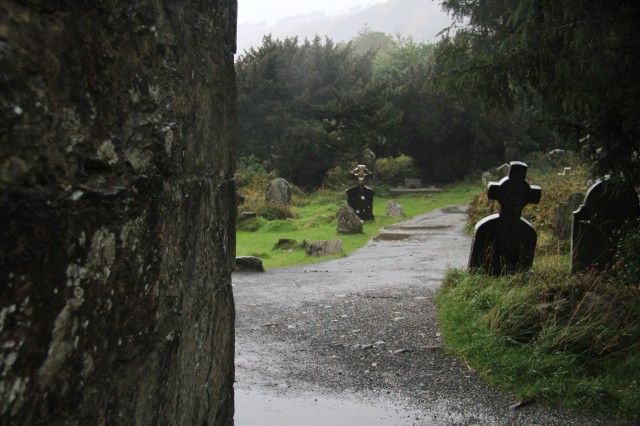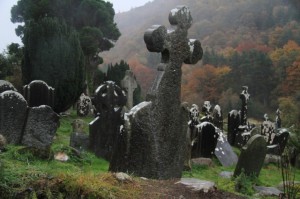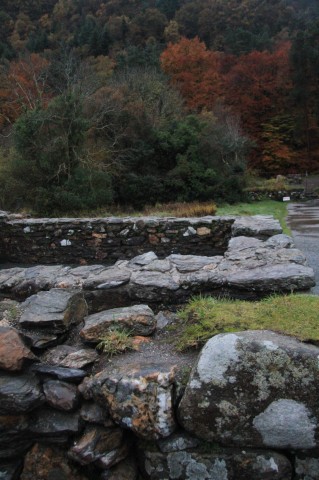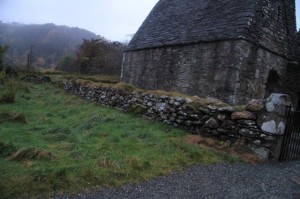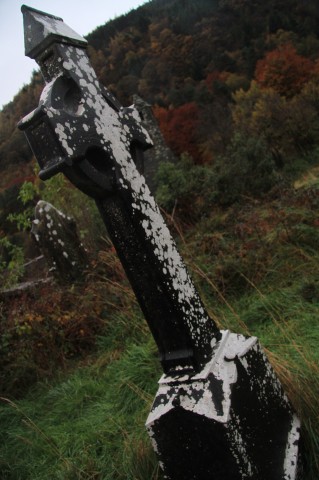Glendalough (Gleann Dá Loch, “Valley of the Two Lakes”) is a fascinating monastic settlement in a spectacular natural setting roughly an hour south of Dublin. It’s known as a ‘sacred’ place and even in the drizzly cold rain and dark November skies, it was incredibly breathtaking. The monastery was founded by St. Kevin, a hermit monk who died about 618 AD. The extensive ruins of Glendalough include several early churches, a graceful round tower, and various sites associated with the life of St. Kevin.
The story of Glendalough begins with St. Kevin (Irish: Coemhghein), a descendent of one of the ruling families of Leinster. As a boy he studied under three holy men (Eoghan, Lochan and Eanna) and as a young man he went to live at Glendalough “in the hollow of a tree.” He returned later with a small group of followers. After a life of sleeping on stones, wearing animal skins, barely eating and (according to legend) making friends with birds and animals, Kevin died in about 618.
Glendalough flourished for the next 600 years, with the deaths of abbots and various raids featuring heavily in the Irish Annals. By the 9th century, it rivaled Clonmacnoise as the leading monastic city of Ireland. In its heyday, the settlement included not only churches and monastic cells but also workshops, guesthouses, an infirmary, farm buildings and houses. Most of the buildings that survive today date from the 10th through 12th centuries.
At the Synod of Rath Breasail in 1111, Glendalough was designated one of two dioceses of the province of North Leinster. An especially notable figure around this period was St. Laurence O’Toole (1128-80), an abbot of Glendalough known for his holiness and hospitality. He was appointed Archbishop of Dublin in 1162, but still returned occasionally to the solitude of St. Kevin’s Bed at Glendalough.
In 1214, the dioceses of Glendalough and Dublin were united, and soon after the cultural and religious status of Glendalough began to decline. The settlement was destroyed by English forces in 1398, but even as a ruin it continued to be a local place of worship and a pilgrimage destination.
Only when you walk through the wet grass, ruins and gravestones do you feel its sacred presence. It may have something to do with the fact that some of the gravestones are thousand years old.
The largest building at Glendalough is the cathedral, which was built in several phases from the 10th through the early 13th century. The earliest part is the nave with antae for supporting the wooden roof. The chancel, sacristy, and north door were added in the late 12th and early 13th centuries.
The chancel arch and east window were once finely decorated, but many of the stones are now missing. Under the south window of the chancel is a wall cupboard and a piscine (basin used for washing sacred vessels). A few meters south of the cathedral is an ancient cross of local granite with an unpierced ring, which is commonly known as St. Kevin’s Cross.
St. Kevin’s Church is a stone roofed building with a distinctive round belfry with conical cap at the west end. The church originally consisted of a simple nave with an entrance at the west end and a small round-headed window in the east gable. A chancel (now missing) and sacristy were added later.
The steep roof, formed of overlapping stones, is supported by a semi-circular vault. The church had a wooden upper floor and there was access to the roof chamber through a rectangular opening towards the western end of the vault.Across the path are the foundations of St. Kieran’s Church, excavated in 1875. The church has a nave and chancel and probably commemorates St. Kieran, the founder of Clonmacnoise – a monastic settlement to the northwest that had associations with Glendalough in the 10th century.
A positive thing about going in the dreary rain late in the day is that NO ONE was there and apparently in the summer, the place can be packed. There’s somehing magical about being among such history and beauty on your own, without the crowds and even without the sun.

Renee Blodgett is the founder of We Blog the World. The site combines the magic of an online culture and travel magazine with a global blog network and has contributors from every continent in the world. Having lived in 10 countries and explored over 90, she is an avid traveler, and a lover, observer and participant in cultural diversity. She is also the founder of the Magdalene Collection, a jewelry line dedicated to women’s unsung voices and stories, and the award-winning author of the bestselling book Magdalene’s Journey
She is founder of Blue Soul Media and co-founder of Blue Soul Earth as well as the producer and host of the award-winning Blue Soul CHATS podcast, that bridges science, technology and spirituality. Renee also founded Magic Sauce Media, a new media services consultancy focused on viral marketing, social media, branding, events and PR. For over 20 years, she has helped companies from 12 countries get traction in the market. Known for her global and organic approach to product and corporate launches, Renee practices what she pitches and as an active user of social media, she helps clients navigate digital waters from around the world. Renee has been blogging for over 16 years and regularly writes on her personal blog Down the Avenue, Huffington Post, BlogHer, We Blog the World and other sites. She was ranked #12 Social Media Influencer by Forbes Magazine and is listed as a new media influencer and game changer on various sites and books on the new media revolution. In 2013, she was listed as the 6th most influential woman in social media by Forbes Magazine on a Top 20 List.
Her passion for art, storytelling and photography led to the launch of Magic Sauce Photography, which is a visual extension of her writing, the result of which has led to producing six photo books: Galapagos Islands, London, South Africa, Rome, Urbanization and Ecuador.
Renee is also the co-founder of Traveling Geeks, an initiative that brings entrepreneurs, thought leaders, bloggers, creators, curators and influencers to other countries to share and learn from peers, governments, corporations, and the general public in order to educate, share, evaluate, and promote innovative technologies.


